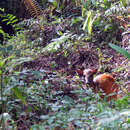Biology
provided by Arkive
Ogilby's duiker feeds on a variety of leaves, shoots, seeds and fruits (2) (4) (10), and, like other duikers, it may follow groups of fruit-eating birds and monkeys through the forest, feeding on dropped fruit (4). Perhaps surprisingly, duikers are also known to occasionally capture small birds and mammals (4). Duikers are thought to play an important ecological role in the forest as seed dispersers and as a significant part of the diet of predators such as leopards (11).
Considered mainly diurnal (10), Ogilby's duiker, like other duikers, is likely to be found either alone or in pairs (4) (7). Interestingly, no Ogilby's duikers are known to be kept in captivity (9). This, together with its secretive lifestyle and inaccessible habitat, means little is currently known about the biology of this elusive species (6). However, it is likely that Ogilby's duiker is monogamous, with a male and female occupying a relatively small home range (5). Female duikers typically bear a single calf, which remains well hidden in the vegetation for the first few weeks of life (4).
Conservation
provided by Arkive
The white-legged duiker, C. o. crusalbum, has probably the most stable population of the three subspecies of Ogilby's duiker, as it occurs in areas where human population densities are low. It is still relatively widespread and common and occurs in a number of protected areas, including Lopé-Okanda National Park and the Gamba complex in Gabon, as well as Odzala National Park in Congo. However, if human populations in these areas increase, the white-legged duiker may become confined within these protected areas in the future (1).
Populations of C. o. ogilbyi and C. o. brookei are decreasing throughout their range. Brooke's duiker, C. o. brookei, has been reduced to around 5,000 individuals and is found in reasonable numbers only in a few areas, such as Sapo National Park in Liberia and Tai National Park in Ivory Coast (1) (9). Mainland populations of C. o. ogilbyi only have a few remaining strongholds, such as Korup National Park in Cameroon. Although this subspecies remains relatively numerous on Bioko Island, the effective protection of Gran Caldera de Luba and the control of the bushmeat trade will be vital to its survival here (1) (9). More public outreach efforts are also needed to educate people about duikers, as well as better monitoring of hunting and enforcement of protected areas (11) (12).
Description
provided by Arkive
A small, secretive antelope, Ogilby's duiker has a stocky body, an arched back, overdeveloped hindquarters, and short, slender legs, all adaptations for moving easily through dense undergrowth (4) (5) (6). The name “duiker” comes from an Afrikaans word meaning “diver”, these antelopes being named for their habit of diving into cover when disturbed (4) (7). Sexes are similar in appearance and both possess short, spike-like horns, which are curved and strongly corrugated (2) (4) (5). The coat is reddish orange, with a red rump, a paler underside, and a black line that runs along the back from the shoulder to the tail, which is short and tufted (2) (4). C. o. crusalbum possesses distinctive white lower legs that distinguish it from all other duikers (8). Like other duiker species, Ogilby's duiker has large scent glands, known as pre-orbital glands, beneath each eye. These are most likely used to scent-mark the territory or even to mark other individuals (4). Somewhat similar in appearance to the bay duiker, Cephalophus dorsalis, Ogilby's duiker can be distinguished by its longer, more slender legs (2).
Habitat
provided by Arkive
This species mainly inhabits moist lowland forest. Although Ogilby's duiker prefers primary rather than secondary forest (1) (9), it has occasionally been reported to 'raid' farmland areas from nearby forest (10). On Bioko Island, Ogilby's duiker has also been recorded from higher altitude montane forest, possibly as a result of the absence of other duiker species that would normally occupy this habitat on the mainland (2).
Range
provided by Arkive
Ogilby's duiker is known from four separate locations within the equatorial forest zone of West Africa. C. o. brookei is found from Sierra Leone to Ghana, C. o. ogilbyi is found on Bioko Island (Gulf of Guinea) and, on the mainland, in parts of Nigeria and Cameroon, and C. o. crusalbum is found in Gabon and in northwest Republic of Congo (1) (9).
Status
provided by Arkive
Classified as Least Concern (LC) on the IUCN Red List (1) and listed on Appendix II of CITES (3). Three subspecies are recognised: Cephalophus ogilbyi brookei (Brooke's duiker) and Cephalophus ogilbyi ogilbyi (Ogilby's duiker) are both classified as Vulnerable (VU) and Cephalophus ogilbyi crusalbum (white-legged duiker) is classified as Least Concern (LC) on the IUCN Red List (1).
Threats
provided by Arkive
The main threats to Ogilby's duiker are habitat degradation and destruction as a result of agriculture, human settlement and logging, as well as over-hunting for the bushmeat trade (1) (2). Hunting is a particular threat to the population of C. o. ogilbyi on Bioko Island (1) (9), and, although still common in the island's protected areas, such as Gran Caldera de Luba (9), monitoring of the bushmeat entering the markets here in 2007 found a worrying increase in the number of animals, including C. o. ogilbyi, being taken from this area (12).
Duikers are popular with hunters because they are easy to hunt, easy to transport by foot, and have enough meat to be highly profitable (11). However, current levels of hunting are thought to be unsustainable (11) and, combined with increasing habitat loss, to which Ogilby's duiker is particularly susceptible due to its restricted distribution and dependence on mature forest, may lead to the further decline of this species in the future (1) (9).

